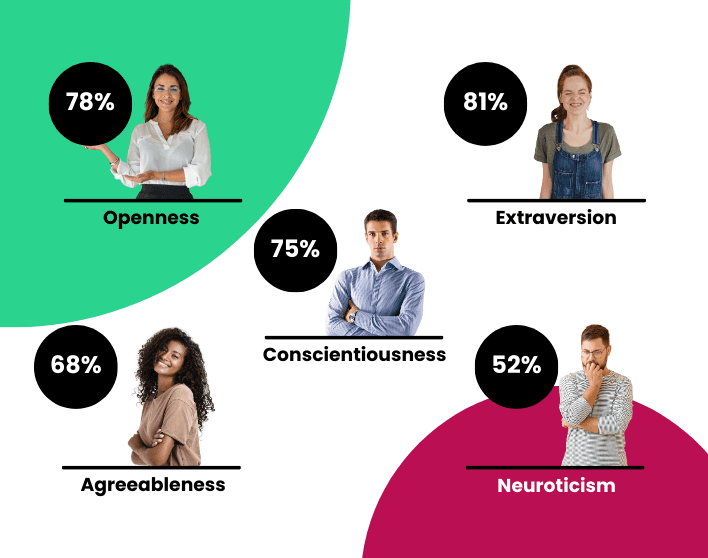The Bryq Team
HR Experts
Many companies pride themselves on their objective recruitment methods. However, hiring bias can still affect your hiring decisions even if you’re not aware of it. You can go through all the processes and remain unaware of the unconscious bias impacting your view of candidates. So, how can you shortlist candidates for job fit without hiring bias?
What is Hiring Bias?
You are likely already aware of the hot topic issues that are gender bias and ethnicity bias. However, there are plenty more forms of hiring bias that are difficult to rid yourself of if you’re not even aware of them.
The confirmation bias, for example, can have a significant impact on recruitment. This is when you already have a perception of the candidate based on their CV or first impression, and everything they say seems to reinforce your judgment. Recruiters suffering from confirmation bias then tend to ignore any potential red flags in that candidate, as they are so committed to their positive impression of that person. This can cause you to overlook some fatal flaws suggesting that they are not the right fit for the job.

How Hiring Bias Affects Recruitment
When hiring bias is present during the recruitment process, this can cause you to make some bad hiring decisions. You may think that some candidates are better than they truly are while making snap judgments on other applicants based on irrelevant factors.
This is how organizations end up with employees all with incredibly similar backgrounds and experiences. It can result in a lack of diversity and means that each applicant is not given an equal opportunity to land the job.
Hiring bias in the recruitment process can give the public a negative perception of your company as well as being bad for business. It can prevent your diversity efforts from being effective, raise your turnover rate, and result in lower-quality hires.
Ways to Shortlist Candidates Based on Job Fitness Without Hiring Bias
Try a Blind Recruitment Process
Blind recruitment is when all identifying candidate details are removed from the CVs and cover letters before the recruiter or hiring manager reviews them. Removing factors such as where someone got their education, name, age, photos, and more can help to minimize hiring bias during the resume screening process.
This provides the opportunity for recruiters to more effectively filter through resumes for the skills required by the role. They can scour the applications looking solely for abilities and not get distracted by personal details that may suggest the background of the candidate. This allows you to focus on reviewing for job fit and take bias out of the equation.
Use A Resume Parser
Adding AI into your recruitment process can produce similar results to conducting blind resume screening. In a similar fashion, a resume parser will seek out specific keywords and phrases that you’re looking for from an applicant. These are usually related to the skills asked for in the job ad and job description.
Depending on what system you select, it can also sort candidates by which criteria they meet. For example, their qualifications, level of experience, and skills. This takes any personal bias out of it and allow you to hire solely for job fit, as human emotion cannot get in the way of finding the right candidate for the role.
Work Sample Test
A work sample test is an assessment given to job candidates that mimics real tasks performed in the role. Respondents are asked to complete the example assignments and are rated on how well they perform. For example, if you are hiring for a receptionist role, you may ask the candidate to respond to incoming emails, arrange someone’s schedule, and book appointments.
This is an excellent addition to the recruitment process because it not only lets you assess job fit by seeing how they would perform in the role, but it can also reduce bias. Make decisions based on the objective data obtained from this process and not your personal opinion of the applicants.
Cognitive Testing
Similarly, cognitive testing can also help to lessen the impact of hiring bias. Test for job fit by presenting candidates with an assessment that measures their cognitive abilities that are relevant to the position. For example, some roles require a high level of analytical ability with numbers. By testing people on this skill, you can decide who to put through to the next step in your recruitment process.
Standardized Interviews
Standardized interviews feature a set of questions that each candidate is asked. As opposed to an unstructured interview, where interviewees can all be asked entirely different questions, a standardized interview gives candidates each the chance to respond to the same questions. This makes it easier to compare candidates against each other and can lessen hiring bias by not allowing interviewers to veer off-topic.
Create a Scoring Matrix
As you have a set of defined interview questions, why not score candidates on how well they respond to these? Adding a score next to each interview answer is an excellent way to compare how well candidates performed in the interview. It can highlight some weaker areas for candidates who you may have previously felt strongly about. This can help to minimize hiring bias, as you are relying on scores and not gut feeling.
If you’ve been struggling to hire based only on job fit, then you’re not alone. Many recruiters battle with hiring bias, as most of it is unconscious. However, by starting to become aware of any judgments you make about candidates, you can begin to change this. Add in some techniques to remove hiring bias from the shortlisting process, and you can be sure that you are hiring the person with the right skills for the position in question. By using more objective recruitment processes, you will have the peace of mind that you are reducing the impact your personal opinions have on who you choose.








